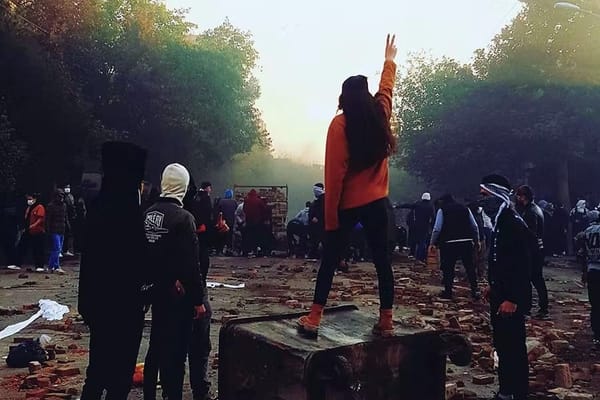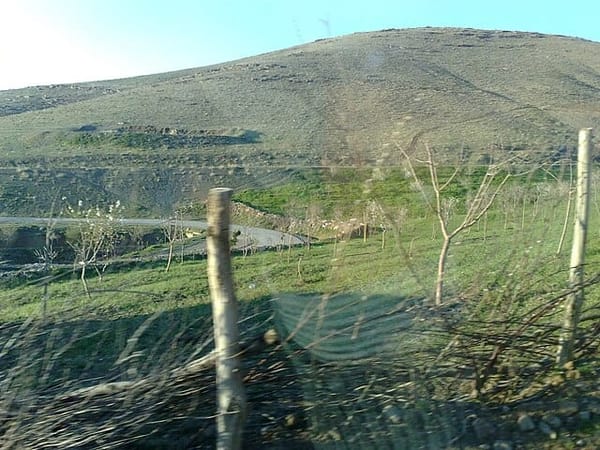Peace with the Devil
“The Great Satan”, a label once wielded by the founder of the Islamic Republic to describe the United States, has long faded from Iranian discourse. Today, few Iranians remember the revolutionary fervor that once infused the phrase.

June 4, 2025
“The Great Satan”, a label once wielded by the founder of the Islamic Republic to describe the United States, has long faded from Iranian discourse. Today, few Iranians remember the revolutionary fervor that once infused the phrase. Mention it in jest, and even younger audiences struggle to recall the ideological backdrop of a grand uprising of the downtrodden against imperialist America.
But while the epithet has receded in Tehran, it has gained new life in the West, reversed and refracted. From George W. Bush’s “Axis of Evil” to the present day, the Islamic Republic itself has increasingly taken on the role of regional villain. In the context of uranium enrichment, Hamas’ October 7 assault, and Houthi missile strikes, the battle between Iran and the West has assumed theological dimensions—a clash cast as light versus darkness.
In this framing, peace with the devil can be read both ways: the righteous world confronting the “Great Satan” that is the United States, or, just as plausibly, the free world reaching out to the actual devil of global terror: the Islamic Republic.
*
When Donald Trump, speaking in Riyadh this past May, extended an olive branch to Iran — standing beside Crown Prince Mohammed bin Salman and other Gulf leaders who applauded at length — Iranians responded with a mix of hope and suspicion. Trump’s speech opened with biting criticism of the Islamic Republic’s leadership, voicing grievances that resonate deeply with many Iranians. He even referenced chronic power outages, water shortages, and environmental devastation—details rarely addressed in official rhetoric. Only after this rebuke did he extend his hand for a nuclear accord.
It was not the message many in the diaspora opposition wanted to hear. Over the past several years, prominent figures and vocal social media users have increasingly aligned with Israeli regional policy. For them, the dream was that a restored Trump-Netanyahu alliance would finally crush the “head of the snake” and bring down the clerical regime once and for all.
Given the quasi-theological rhetoric that defines both Iranian and Israeli state discourse—each reducing the enemy to an apocalyptic evil—I quipped on Facebook at the time: “Looks like the Iranian middle class must choose between Trump’s olive branch and Bibi’s spear. Peace or missiles?” One, I joked, promised material gains and sanctions relief; the other offered retribution against the clerics and the Islamic Revolutionary Guard Corps, perhaps even regime change.
On one side are reformist insiders and Masoud Pezeshkian’s cabinet. On the other are exiled or disillusioned former reformists turned oppositionists—monarchist or republican, based in Iran or abroad. The “spear,” in this metaphor, replaces Moses’ staff—a hard-right fantasy that imagines piercing seas and stone walls to deliver the exiled Opposition into a promised homeland.
I focus here on the middle class because what we tend to call “Iranian public opinion” is, in truth, a projection of middle-class interests. Most domestic media—and nearly all media in exile—are dominated by this demographic. Their political voices are the reformists (inside Iran) and the Opposition (abroad). The distinction between “inside” and “outside” is more political than geographical.
What we seldom hear is the voice of the working class: laborers, the downwardly mobile, and ethnic minorities in impoverished provinces. Often employed in informal service roles and excluded from full citizenship by ethnicity or poverty, these groups remain largely invisible in the media landscape.
This observation is not grounded in hard data, because such data doesn’t exist. But consider this: much of the political, economic, and cultural discourse in Iranian media (both inside and outside the country) is crafted as if its primary audience were an archetypal middle class, regardless of the universal language of “national interest.”
U.S. foreign policy toward Iran has consistently exposed this class fault line, swinging between Trump’s olive branch and Netanyahu’s fury.
First Trend
Shopkeepers, importers, and tech entrepreneurs rely on dollars, navigating sanctions through an elaborate web of currency exchanges and banks in East Asia. For them, the removal of economic and banking sanctions is paramount. Their elite lifestyles, both in Iran and abroad, have long mirrored Western standards. Their aspirations are broadcast through an army of social media influencers and glossy lifestyle content: designer brands, private clinics, digital gadgets, and aspirational travel.
They are not regime insiders, nor are they beneficiaries of nepotism. They are doctors, nurses, architects, coders, and other skilled professionals who dream of owning a home and car through years of honest work. War, bombing, border closures, and airport shutdowns directly threaten their economic security. For this group, Trump’s olive branch—and the hope of future foreign investment, even under clerical rule—is preferable to the chaos of military confrontation.
But what of the working class? How is their reality represented in the media? It isn’t.
A tragic incident in late April made this absence heartbreakingly clear. On April 26, a massive explosion rocked a warehouse in Bandar Abbas. Among the dead and injured were a large number of undocumented Baluch laborers. Deprived of education, healthcare, and legal employment due to ethnic discrimination, they were uninsured and uncounted. Their bodies vaporized in the blast—leaving no remains to bury, no names to mourn publicly. In both life and death, they were rendered invisible.
Iran has one of the world’s highest execution rates relative to population—comparable only to China. Most of those executed are from ethnic minorities: Baluch, Kurdish, and Arab. The recent rise in border killings of fuel smugglers and couriers only adds to the toll. So, one must ask: will dollar diplomacy or missile diplomacy change anything for these citizens?
*
Class interests shape perception. A quick survey of Iranian YouTube and Instagram reveals a booming genre I call “My American Dream.” In video after video, young couples document their odyssey—securing visas, packing their lives, and relocating to New York, Los Angeles, Austin, Atlanta, Toronto, or Vancouver. They film apartment hunting, new jobs, tourist excursions, and the joys of Western consumerism. This content is steeped in lifestyle aspirations—food, fashion, leisure—not art museums, literary history, or theater. It’s not ignorance. It’s survival. These migrants are not elite scions of the regime. They are self-made professionals, reclaiming a life of dignity denied to them at home.
Politics rarely intrudes on these narratives. That’s intentional. No one wants to jeopardize a path back home over ideological grandstanding.
Second Trend
The Opposition, meanwhile, operates under its own iron logic: any action that delays regime collapse is tantamount to betrayal. Sanctions must remain. “Maximum pressure” is the only viable path to regime change. Until the clerics are buried, Iran will never be Dubai! Olive branches are the appeasement of Obama and Biden; Trump must not be duped.
At a recent “Regime Change in Iran” summit—hosted by the pro-Israel Middle East Forum—activist Masih Alinejad denounced any negotiations with Tehran. “Don’t be allergic to regime change!” she urged the cheering audience. She warned of Iranian influence infiltrating American universities and painted the regime as an existential threat to the U.S., Israel, and the region.
Many popular opposition pundits—on networks like Manoto, Iran International, and Voice of America—have affiliations with pro-Israel think tanks. Last fall, analysts Saeed Ghasseminejad and Behnam Talebloo of the Foundation for Defense of Democracies published a policy brief mapping Iranian military and infrastructure targets for possible Israeli strikes. Ghasseminejad is an avowed monarchist and supporter of restoring the Pahlavi throne.
*
From velvet revolutionaries in the mold of Václav Havel (Nasrin Mohammadi), to Cold War liberals of the “Free World” (Bahareh Hedayat, Alinejad), to right-wing authoritarians banking on Netanyahu (Pan-Iranists, opposition media, King Reza loyalists)—they all share one core belief: the Islamic Republic will never be normalized. It will never become Turkey, Dubai, or South Korea. Its theocratic, anti-Western ideology defines its identity. It is only for tactical reprieve when it compromises—until the next proxy offensive. The Opposition insists that not just Iran but the entire Middle East must be cleansed of these theocratic forces. “The true occupiers,” they say, “are not Netanyahu’s troops—but these clerics and their militias.” What could be more nightmarish than seeing Tehran become another Dubai under this same regime?
And that, precisely, is the nightmare Trump revived in Riyadh.
There, he denounced both the “interventionist neocons” of his party and the “NGO liberals” of the Democrats—his words—disavowing the legacy of Bush, Biden, Clinton, and Obama, the arsonists of the Middle East. “We will lift Syria sanctions,” he declared to thunderous applause. “We’ll broker a truce with the Houthis,” more applause. Then, after a brief lashing of Tehran’s corruption and incompetence, he extended an olive branch to the Ayatollah—at minute 29 of the speech—met by cheers from the robed dignitaries of the Gulf.
Why stage a military coup or bomb Iran’s infrastructure when the clerics can simply make peace with the Gulf monarchs and sign their own Abraham Accord? Why not buy Boeing jets, mobile phones, and crypto from the Great Satan?
Time is short. The choice must be made: Trump’s olive branch—or Bibi’s spear?
—A.K.



